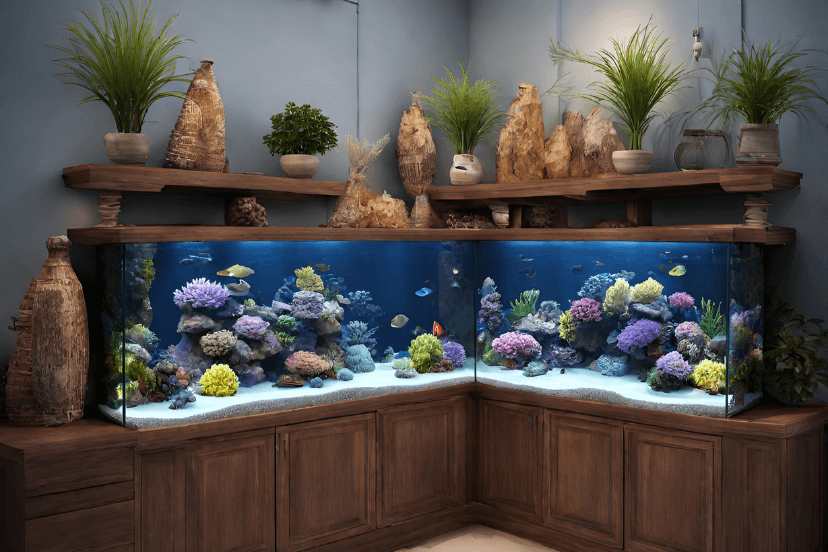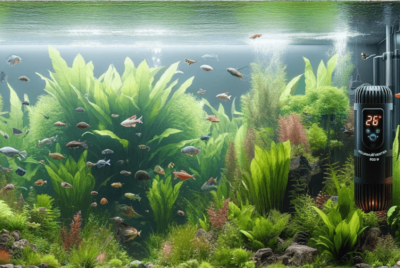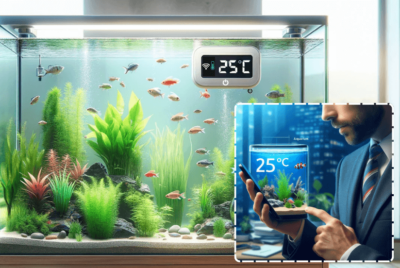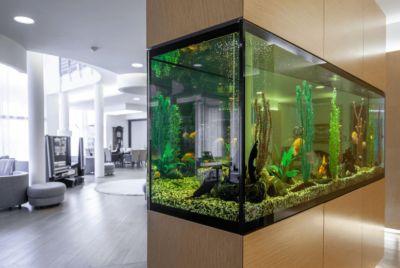Saltwater Fish Tank Guide: Choosing the Right Fish
Hello there, ocean lover! Ever fancied the idea of capturing a piece of the vast and enigmatic ocean right in your living or office space with a saltwater fish tank? You’re certainly in good company. The mesmerizing appeal of glistening scales, radiant colors, and tranquil marine vistas is truly undeniable. As your companion and fellow aquarium enthusiast, I’m here to guide you through the exhilarating process of creating your very own saltwater fish tank. Selecting the perfect marine inhabitants involves much more than their visual appeal; it’s about designing a harmonious, thriving marine environment that enhances your space. Whether it’s for the comfort of your home or the elegance of your office, a saltwater fish tank brings a slice of oceanic wonder to your daily environment. Are you ready to embark on this fascinating journey with me? Let’s set sail into the captivating world of saltwater aquariums!
Setting the Stage: Understanding Your Aquarium
Embarking on a saltwater fish tank adventure? Beginning this journey is more than just adding water and fish. It involves grasping the complex ecosystem within your aquarium. Understanding the intricate balance of a saltwater fish tank is key. It lays the foundation for a thriving aquatic environment. Explore the essentials of maintaining a vibrant saltwater fish tank.
Diving deeper, every element in your saltwater fish tank plays a crucial role. From the salinity of the water to the type of filter, each component affects the tank’s health. Familiarizing yourself with these aspects ensures your saltwater fish tank flourishes. Start your saltwater fish tank journey on the right foot. Embrace the basics, and watch your underwater world thrive.
The Basics of a Saltwater Fish Tank
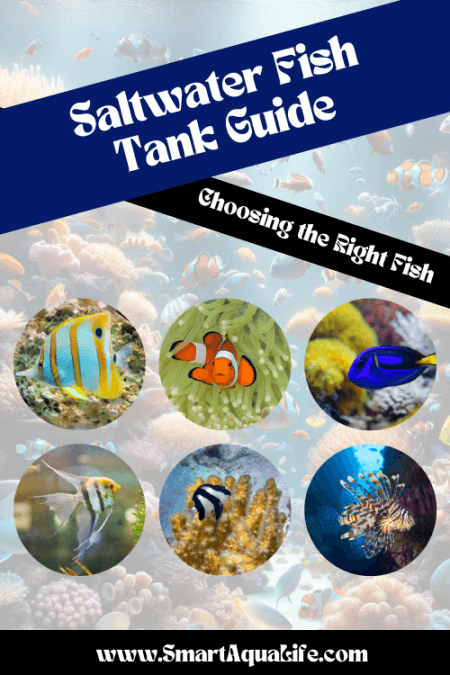
Saltwater fish tanks are like having mini oceans right in your living room. What’s the secret to their success? Balance and the right ingredients. To create a thriving saltwater fish tank, use marine salt mix, not just any table salt. This special mix is crucial for replicating the natural ocean conditions your marine life needs to flourish. When it comes to equipment, don’t skimp. Quality filtration and lighting are investments in the health and vibrancy of your saltwater fish tank. This careful setup lays the groundwork for a dazzling array of marine life, from the flash of colorful fish to the delicate beauty of corals.
Understanding that your saltwater fish tank is more than just an aquarium; it’s a complex ecosystem, is vital. Each component, from the water you pour in to the creatures you introduce, plays a pivotal role in this delicate marine ballet. Regular maintenance and monitoring are essential to keep everything in harmony. With patience and attention to detail, your saltwater fish tank can become a mesmerizing underwater haven. Remember, creating a successful saltwater fish tank is a journey, one that rewards you with a slice of the ocean’s majesty right in your own home.
Deciding on the Tank’s Size and Capacity
Size matters in saltwater fish tank. Small tanks may be tempting but pose challenges in maintaining stable water conditions. Beginners should consider starting with at least a 30-gallon tank. It’s a sweet spot for easier management and a variety of marine life. Dreaming big? A larger tank, 55 gallons or more, offers stability and room for a dazzling reef setup. Choose based on space, budget, and the marine diversity you aim to achieve.
Dive Into Diversity: Popular Saltwater Fish Species
Discover the underwater rainbow with these popular saltwater fish species. From beginner-friendly options to more challenging choices, there’s a fish for every type of aquarist.
The Vibrant Clownfish

Iconic and beloved, the Clownfish is a saltwater fish tank staple. Known for their bright orange color with white stripes, they’re not just a joy to watch but also hardy. Clownfish thrive in symbiotic relationships with anemones, making them a fascinating addition to any tank.
Majestic Tangs

Tangs, with their striking colors and elegant fins, add a dash of majesty to any marine setup. They’re excellent algae eaters, keeping your tank clean. Tangs require larger tanks to swim freely, making them ideal for seasoned hobbyists ready to scale up.
Graceful Angelfish

Angelfish are the jewels of the ocean. With their unique shapes and mesmerizing colors, they bring grace to any saltwater tank. They do best in well-established aquariums with plenty of hiding spots and live rock to graze on.
Hardy Damsels

Damsels are the go-getters of the saltwater world. Small yet vibrant, they’re known for their resilience, making them perfect for beginners. However, their feisty nature requires careful consideration when choosing tank mates.
The Enigmatic Lionfish

Lionfish, with their dramatic appearance and flowing fins, are a sight to behold. While stunning, they’re also predators with venomous spines, requiring an experienced hand and a species-appropriate tank setup. Their unique look makes them a centerpiece in any saltwater fish tank.
Caring for Your Saltwater Fish
Ensuring your marine friends thrive requires knowing the essentials of saltwater fish care. Let’s explore how to maintain optimal water conditions and feeding routines.
Optimal Water Conditions
Achieving and maintaining the right water parameters is crucial for a healthy saltwater fish tank. Keep your salinity levels between 1.020 and 1.025 specific gravity. Temperature should remain steady around 75-80°F (24-27°C) for most species. Regularly test for pH, ammonia, nitrites, and nitrates, aiming for a pH of 8.1-8.4. Stability is key; abrupt changes can stress your aquatic pals.
Feeding: What, When, and How Much?
Feeding your saltwater fish correctly is vital for their health. Offer a varied diet—frozen, live, and dry foods—tailored to their specific needs. Most fish thrive on two small feedings per day. Overfeeding is a common mistake; give only what they can consume in 3-5 minutes to avoid polluting the tank. Observing your fish’s feeding habits helps them customize their diet for optimal health.
Creating a Harmonious Community
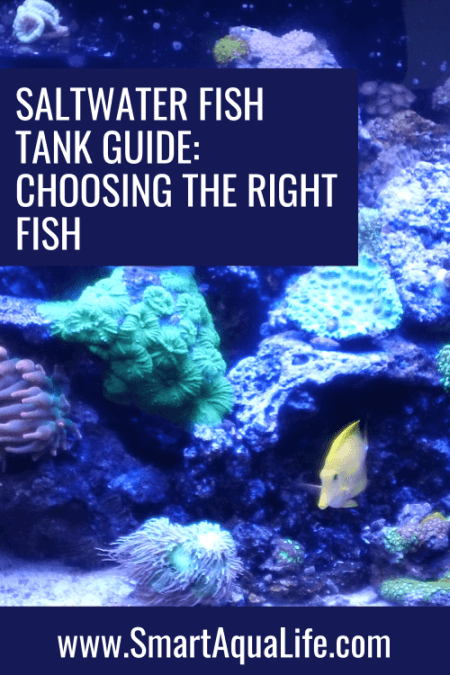
Building a peaceful marine world involves understanding fish compatibility and avoiding overcrowding. Let’s dive into how you can achieve harmony under the sea.
Fish Compatibility
Not all fish play well together. Research is key to a harmonious tank. Some species are territorial, while others are peaceful. Mixing aggressive with timid fish can lead to stress and conflict. Look for fish that share similar water condition preferences and behaviors. Compatibility charts can be a helpful guide in selecting tank mates that are likely to get along.
Avoiding Overcrowding
More fish means more problems. Overcrowding can lead to increased aggression, stress, and disease, not to mention taxing your filtration system. A good rule of thumb is to allow at least 5 gallons of water per inch of fish. This ensures each fish has enough space to thrive and the water quality remains high. Planning your stock levels carefully can prevent overcrowding issues and keep your aquatic community healthy and happy.
Advanced Care for Enthusiasts
Diving deeper into the realm of saltwater fish tanks opens up a world of rare beauties and the rewarding challenge of breeding. Let’s explore these advanced aspects.
Rare and Exotic Species
Adding rare and exotic species to your tank brings unparalleled beauty and intrigue. Research is crucial; these species often require specific water conditions, diets, and tank mates. Species like the Blue Ring Octopus or Peacock Mantis Shrimp offer extraordinary visuals but come with unique care requirements. Commitment to their well-being is key, as is readiness for the challenges they present.
Breeding Saltwater Fish
Breeding saltwater fish is a journey of patience and precision. Success varies widely among species, with some like Clownfish being more accessible to breed. Understanding the breeding behavior and specific needs of your chosen species is vital. This might include adjusting tank conditions, providing proper nutrition, and sometimes even rearing the fry separately. Breeding not only offers personal satisfaction but also contributes to the sustainability of marine species.
The Technical Side of Things
Mastering the technical side is essential for a thriving saltwater fish tank. Let’s break down the basics of filtration and lighting, and the importance of water quality.
Filtration and Lighting
Effective filtration and proper lighting are the heart and soul of any saltwater aquarium. Choose a filtration system that matches your tank’s size and inhabitants’ needs—mechanical, chemical, and biological filters keep the water clean and healthy. Lighting, on the other hand, is not just about aesthetics. It supports the life of corals and plants, with LED lights offering a spectrum suitable for growth and showcasing the vibrant colors of your tank.
Monitoring and Maintaining Water Quality
Water quality can’t be overlooked. Regular testing for pH, ammonia, nitrite, and nitrate levels is necessary. Invest in a quality test kit and aim for consistency in your water parameters. Regular water changes, not exceeding 20-25% at a time, help in maintaining a pristine environment. Remember, stability is key to preventing stress in your aquatic life.
Integrating Smart Aquarium Technology
In the quest to choose the right fish for your saltwater fish tank, smart aquarium technology emerges as a game-changer. Innovative tools like automatic feeders, programmable LED lights, and digital water quality monitors help mimic natural conditions, ensuring your marine inhabitants thrive. These technologies not only simplify the care process but also provide a stable environment, critical for the well-being of sensitive species. By integrating smart tech, you can monitor and adjust your aquarium’s parameters remotely, making it easier to maintain optimal conditions for your chosen fish. Embrace smart aquarium technology to elevate your fishkeeping experience, creating a vibrant underwater world with the flourish of technology.
Embarking on Your Saltwater Fish Tank Journey
Ready to dive into the saltwater hobby? Here’s what you need to keep in mind: planning, patience, and the willingness to learn and adapt.
Planning and Patience
Every successful aquarium starts with a plan. Consider the size of your tank, the species you wish to keep, and their compatibility. Patience is crucial; don’t rush the cycling process or the introduction of new inhabitants. A well-thought-out approach and patience in the early stages pay off with a healthy, vibrant aquarium.
Continuous Learning and Adaptation
The learning never stops in the world of saltwater fish tank. Stay open to new information, techniques, and technologies. Conditions in your tank will change, and challenges will arise. The ability to adapt and learn from these experiences is what makes a successful aquarist. Join forums, read articles, and connect with fellow enthusiasts to share knowledge and insights.
Conclusion
Starting your saltwater fish tank journey is not just an exciting adventure; it’s a gateway to a world of endless possibilities, right in your own home or office. Imagine having a vibrant, thriving slice of the ocean as a centerpiece in your living space, captivating the eyes and hearts of all who gaze upon it. The secret to a flourishing marine habitat is rooted in mastering the basics—from selecting the right mix of colorful fish to ensuring the environmental conditions are just perfect. But it’s more than just science; it’s an art that requires patience, a willingness to learn, and a sprinkle of creativity.
As you embark on this mesmerizing journey, remember that each step forward brings you closer to creating an awe-inspiring underwater realm. It’s about transforming your vision into reality, one that mirrors the beauty and diversity of the ocean’s depths. By dedicating yourself to continuous learning and adapting, you’re not just maintaining an aquarium; you’re nurturing a living, breathing marine ecosystem. So, why wait? Dive into the adventure of building your saltwater fish tank. The waters of creation are inviting, and the beauty of the underwater world awaits to unfold before you.
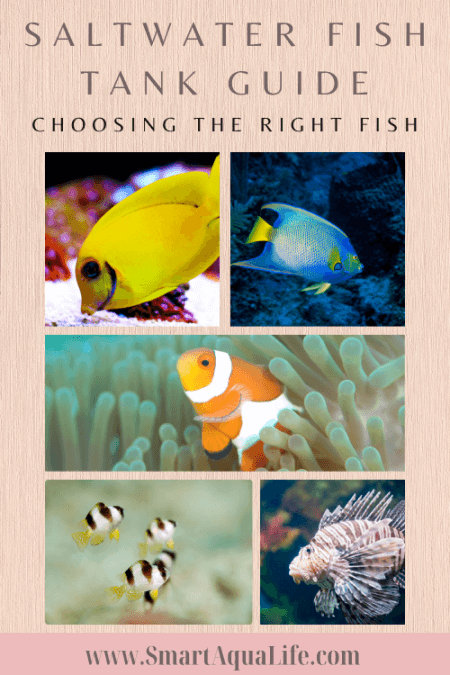
FAQs
Q: How do I start a saltwater fish tank?
A: Begin with research. Decide on the tank size, then invest in quality equipment like a filtration system, heater, and lighting. Cycle your tank to establish beneficial bacteria before adding any fish. Start with hardy species as you learn the ropes.
Q: What are the best saltwater fish for beginners?
A: Clownfish, damselfish, and blennies are excellent choices for beginners. They’re hardy, adaptable, and less demanding, making them perfect for those new to saltwater fish tank.
Q: How often should I clean my saltwater tank?
A: Perform partial water changes of 10-20% every two weeks to maintain water quality. Regular testing and observation will guide your maintenance schedule, ensuring your tank remains healthy and balanced.
Q: Can I mix different species of saltwater fish?
A: Yes, but with caution. Research compatibility to avoid aggression and ensure peaceful coexistence. Consider size, temperament, and environmental needs to create a harmonious community.
A: Q: What should I do if a fish gets sick?
Isolate the sick fish to prevent the spreading of illness. Identify the symptoms and research possible treatments. Consider water quality issues first, as they’re a common cause of stress and disease in fish.

